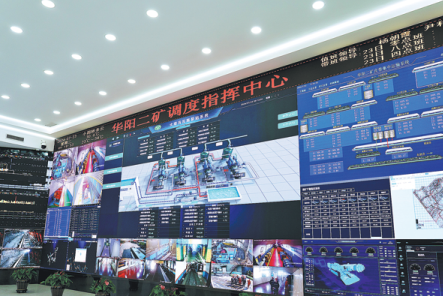Energy transformation spurs economic growth
Updated: 2024-08-09
China has set its goals for low-carbon development: to reach peak carbon before 2030 and carbon neutrality before 2060.
The North China province of Shanxi, with coal mining as its traditional pillar industry, is implementing its own measures to meet these goals through a large-scale industrial transformation initiative that is upgrading its coal industry and fostering new, green industries that can drive low-carbon development.
An active player in Shanxi's industrial transformation, the city of Yangquan, located in the east of the province, is using cutting-edge technologies to upgrade traditional industries and foster emerging sectors as new growth drivers.
Like the rest of Shanxi, coal mining had been the dominant industry in Yangquan for decades. But now the city has been given a new lease on life thanks to efforts to upgrade coal-mining facilities and boost economic diversification through developing new industries.
An affiliate to the local coal-mining giant of Huayang Group, Huayang No 2 Mine is an old coal-mining facility with a history of more than 70 years. It is seeing a rejuvenation thanks to digital empowerment and smart mining construction.
Huayang No 2 began smart mining construction in December 2021. Since then, it has developed nine intelligent operational subsystems for areas including infrastructure management, geological safety guarantee and coal cutting. The subsystems have been integrated through a comprehensive operational platform, substantially improving the coal mine's operations, safety and efficiency, according to executives.
The coal mining company now boasts nine intelligent mining shafts and 19 smart coal-cutting sites, featuring such technologies as 5G connection, remote monitoring and automation.
"The automation rate of our mining shafts and coal-cutting sites reached 90 percent," said Wu Ruiming, an executive of the company. "This has led to greater safety, as it is commonly recognized in the coal-mining industry that 'less manpower means better safety'."
Wu also noted that the daily work period of in-shaft workers has been reduced by about five hours, also leading to better safety and efficiency.
"In the next stage, we will use such technologies as artificial intelligence and robotics to further increase safety and efficiency," Wu said.
While Huayang No 2 is devoting much energy to the intelligent upgrade of traditional coal-mining operations, other companies in Yangquan have delved into various emerging sectors.
One such company is Huana Xinneng, which is also a branch company of Huayang Group and a developer of new types of batteries. Unlike the popular lithiumion battery, what gives it an edge are sodium-ion batteries.
Nowadays, lithium-ion batteries have been applied to portable electronics and electric vehicles due to high energy density, long work life and environmental benefits. But limited lithium resources and high costs have impeded the application of lithium-ion batteries in large-scale energy storage systems.
Because of sodium's high abundance, low cost and suitable redox potential, some companies in China are developing applicable sodium-ion batteries as a substitute of lithium-ion ones, according to a report released by the University of Science and Technology of China. Huana Xinneng is one of such companies.
"Lithium-ion batteries are now increasingly popular in many application scenarios," said Luo Zhenhua, an executive of Huana Xinneng. "But there are still limits to the batteries. For instance, the mileage of lithium-ion battery vehicles can be drastically reduced in low temperatures and the batteries cannot be used in scenarios with strict requirements in safety."
He added that such shortcomings can be overcome by sodiumion batteries.
Compared with lithium-ion batteries, sodium-ion batteries feature better safety performance, better adaptivity to temperature change and a longer life cycle.
"In a temperature as low as-20 C, the capacity of some sodium-ion batteries can be kept at 80 to 90 percent," Luo said.
Huana Xinneng began to develop sodium-ion batteries in 2021. It realized volume production of cylindric cells and battery packs in 2023 and began mass production of square cells in April this year.
According to Luo, square cells are the upgraded version from cylindric cells, featuring a larger capacity in energy storage.
Jin Shenglong, board chairman of Huana Xinneng, said the company will continue to boost the growth of the sodium-ion battery industry, contributing to Shanxi's and China's low-carbon development.
Jinyang New Energy Power, based in Yangquan's Yuxian county, is another example of Shanxi's industrial transformation in diverting its operations from coal-fired generation to solar power business.
The company has a coal-fired power plant near a coal mine. After decades of development, the mine had seen its reserves depleted in recent years. Land subsidence was the direct outcome of this.
To make better use of the coal mine's land, Jinyang New Energy Power developed a large solar farm on the surface of the mine after refilling it.
With a total investment of 727.97 million yuan ($101.74 million), the solar farm can generate 128 million kWh of electricity annually. Compared with the former coal-fired facility, this translates into a reduction of 127,600 metric tons of carbon dioxide emission every year, according to Lu Haijun, head of the company.
"We have seen great environmental benefits from this new (solar power) business," Lu said. "We are developing the solar farm while repairing the local environment and restoring the ecosystem."
More importantly, Lu said the new facility has brought new jobs to workers who were on the verge of unemployment because of the depleted mine reserves. With the expansion of the solar farm, rural residents in the vicinity were also offered jobs.
"As a solar power enterprise, we are benefiting from the fast-developing photovoltaic technologies," Lu said. "In the years to come, along with our business expansion, we will promote our operational experience to the rest of the county and even the province, bringing more benefits to the people and the environment."
Feng Siquan contributed to this story.

Large screens display data at the operational center of Huayang No 2 Coal Mine. Provided to CHINA DAILY

